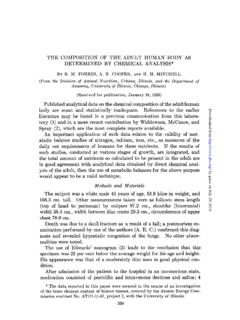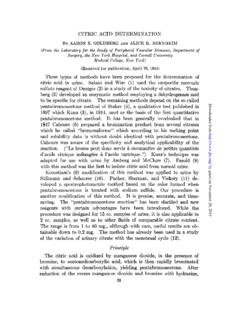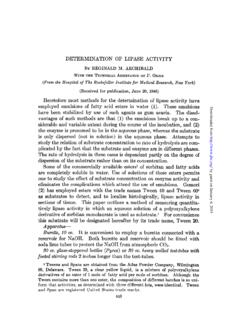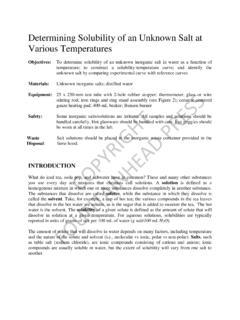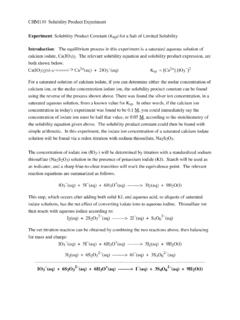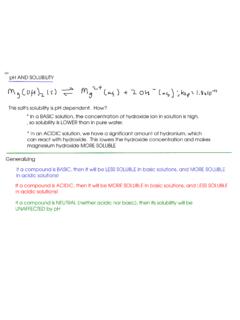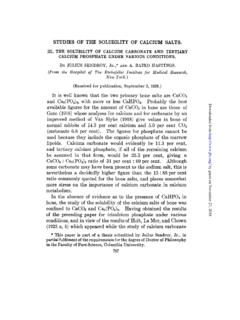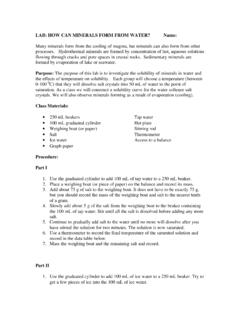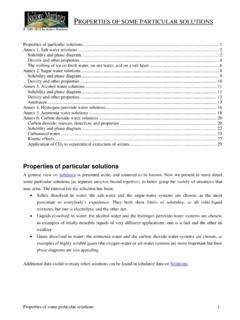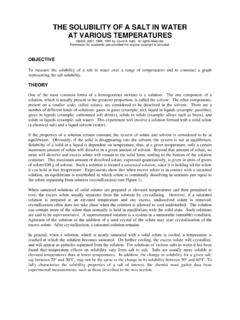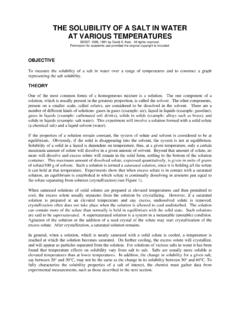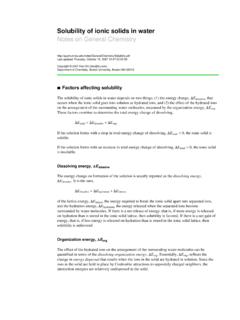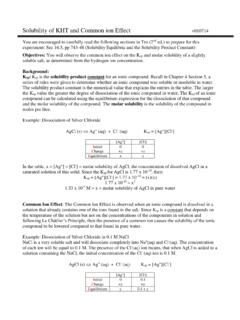Transcription of SOLUBILITY DATA FOR VARIOUS SALTS OF LAURIC,
1 SOLUBILITY data FOR VARIOUS SALTS OF LAURIC, MYRISTIC, PALMITIC, AND STEARIC ACIDS.* BY C. A. JACOBSON AND AUGUST HOLMES. (Fran? the Department of Chemistry, Unioersity of Nevada, Rena.) (Received for publication, March 15, 1916.) The isolation of individual members of t he higher saturated fatty acids, when occurring in mixtures of such acids, has always been fraught with considerable, if not insurmountable difficulties. The authors, in their characterization of the constituents of alfalfa seed oil, were confronted with the same difficulties. After applying all the known methods that were available for these separations, and finding that unsatisfactory results were ob- tained in every case when artificially prepared mixtures of the fatty acids were employed, it was decided to investigate the solu- bilities of VARIOUS SALTS of lauric, myristic, palmitic, and acids in a number of organic solvents as well as in water.
2 It was hoped that the SOLUBILITY data thus obtained would fur- nish the means for a scheme of separation of the different acids, but just how far these anticipations were realized will be discussed in another paper. The property of SOLUBILITY has furnished the basis for more sys- tems of separation of chemical substances than any other, although differences of melting point, boiling point, and volatilization in steam are properties upon which schemes of separat ion have been founded. The following tables include the SOLUBILITY of the lithium, magnesium, beryllium, barium, lead, and silver SALTS of l&uric, myristic, palmitic, and stearic acids in two or more of the follow- ing solvents: water, ethyl and methyl alcohol, ether, benzene, ethyl acetate, methyl acetate, amyl alcohol, amyl acetate, chloro- * This in-iestigation was carried out at the Nevada Agricultural Expcri- ment Station with funds obtained under the Bdams Act.
3 1 Jacobson, C. A., and Holmes, A., J. A,n. Chem. Sot., 1916, xxxviii, 450. 29 by guest on December 18, 2020 from SOLUBILITY data for VARIOUS SALTS form, and acetone, at room temperature, 25 , 35 , and 50 , whenever the boiling point of the solvent permitted. The solvents were selected according to their most probable applicability along this line. They were of the highest purity obtainable and always redistilled whenever any question as to their purity arose. In general the SALTS of the fatty acids were made from the acetates of the metals, but a detailed description of the preparation of each salt will be given in connection with its table of solubilities. ,4n excess of the salt to be investigated was put into a 100 cc.
4 Round bottom flask having a neck about 5 inches long. Four such flasks were used at the same time for the four different SALTS of a given metal and the flasks filled nearly full with the solvent to be employed. The flasks were then stoppered and clamped in a shaking device, which was so arranged that the flasks, excepting the upper part of the necks, were immersed in a bath of water whose temperature was kept constant to within . An elec- tric motor was used for shaking the flasks in the water bath and the agitat,ion continued for 2 hours after the liquid in the flasks had assumed the temperature of the water in the bath. The shaking was then interrupted and the suspended matter allowed to settle, after which about 10 cc.
5 Of the solution were rapidly drawn off with a carefully calibrated pipette, the solution was weighed in a covered weighing tube, and finally the solvent evap- orated off. From the weight of the residue in the weighing tubes the SOLUBILITY was calculated in terms of gm. of salt , soluble in 100 gm. of solvent. We did not attempt to obtain absolute solubilities in any case, although most of the data here submitted will approach the abso- lute values very closely. It has been learned that in some in- stances a 6 hour shaking in contact with the solvent is not suffi- cient to secure maximum SOLUBILITY , but for the solvents used the difference between the SOLUBILITY after 2 and 6 hours shaking is so slight that for all practical purposes it may be neglected.
6 Amy1 alcohol may be considered an exception to this rule for it was found that a 2 hour shaking in most cases did not suffice to produce a saturated solution. The results recorded under this solvent are those obtained after 2 hours shaking, making them comparable with those of the other SALTS . by guest on December 18, 2020 from C. A. Jacobson and A. Holmes 31 In the first table will be found the results of analyses of the four fatty acids and their SALTS which were employed in obtaining the following SOLUBILITY data . TABLE I. - -- ..- M. p. M. p.. Neutralization value .. Xeutralization value . M. p. Li .. Per cent of Li in Li salt .. Per cent of Li calcu- M. p. Mg .. Per cent of Mg in Mg salt .
7 Per cent of Mg calcu- M. p. Pb salt . Per cent of Pb in Pb salt .. Per cent of Pb calcu- lated .. Per cent of Ba in Ba salt .. Per cent of Ba calcu- 3%. p. Ag salt .. Per cent of Ag in Ag salt .. Per cent of Ag calcu- Laurie acid. Myristio acid. 280 0 212-213 211 - .- 1 - Palmitic acid Steeric acid. -- 2 Ol 69 0" " 224-225 121-122 209 o 132 205 - In Table II will be found the analyses of the beryllium SALTS of the four fatty acids which were prepared in the following man- ner: To 10 gm. of the acid dissolved in 95 per cent alcohol (the solution neutralized with alcoholic ammonium hydroxide, using lit- mus as the indicator), a calculated amount of beryllium nitrate dissolved in alcohol was added.
8 The resulting precipitate was by guest on December 18, 2020 from 32 SOLUBILITY data for VARIOUS SALTS washed several times with boiling alcohol, both by decantation and in a filter, then dried and subjected to analysis with the fol- lowing results. TABLE II. Per cent of Be found .. Calculated for Be (AC)?.. Ratio : Found Calculated .. Hence, calculated for Be(OH)Ac, Per cent of C . Calculated for Bc(OH) Per cent of H . Calculated for Bc(OH) T 3e laurate Be myris- tate. - -- - Be palmi- tate. B e stearste. The above results show that the basic SALTS of beryllium with the formula Be(OH)Ac were obtained rather than the normal Be(Ac)P SALTS .
9 They were found to be only very slightly soluble in the general organic solvents, but for the sake of completeness their solubilities were determined in ethyl and methyl alcohol at 25 . Table III contains these data . TABLE III. Soluldit~y OJ Acid SALTS oj Beryllium at 25 . Ethyl alcohol gm. salt 100 gm. solvent .. Ncthyl alcohol gm. salt 100 gm. solvent. Laurate.. Myristate. Palmitate. Stearate.. Table IV contains the SOLUBILITY data for the lithium SALTS pre- pared by adding a calculated amount of lithium acetate to-the alcoholic solutions of the respective fatty acids. The precipi- by guest on December 18, 2020 from C. A. Jacobson and A. Holmes 33 tates formed were dissolved in boiling alcohol and the solutions allowed to stand over night in a cool place.
10 The SALTS that had separated were washed and dried. TABLE IV. SOLUBILITY of Lithium SALTS in Ethyl :Ilcohol (Absolute). j salt . 1 Solution. 1 Solvent. Temperature 20 salt in 100 gm. solvent. gm. gm. g,n . Laurate .. Myristate .. Palmitate .. Stearate .. gm. Temperature Laurate .. Myristate .. Palmitate .. Stearate .. Temperature 35 -__ Lauratc .. Myristrtte .. 0 0215 Palmitatc .. Stearate .. Temperature 50 --- Palmitate. Temperature 65 .. by guest on December 18, 2020 from 34 SOLUBILITY data for VARIOUS SALTS The solubilities here recorded are practically the absolute solubilities of the SALTS used, if the results of Partheil and Feri& can be taken to represent absolute solubilities.


